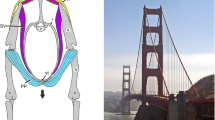Abstract
Our experiments addressed the problem of the regulation of the number of mechanoreceptors by sensory axons and/or their peripheral target tissues. According to a previous study (Zelená et al. 1997) white leghorn chickens have more muscle spindles in the plantaris muscle (45.4±7.8; mean ±SD) than the Japanese quail (35.3±4.8) and significantly more Herbst corpuscles in the crural region (380.0±85.0) than the quail (124.9±32.8). Embryonic chick-quail chimeras were therefore used as a model with distinct recombinations of the nerve supply and peripheral tissue for studying the developmental control of these mechanoreceptors. The chick host leg bud was replaced with a quail leg bud of equal age and vice versa on embryonic day 3, prior to the onset of innervation of the periphery. Shortly before hatching the chimeras were sacrificed and muscle spindles and Herbst corpuscles counted. Recombinations of chicken nerves with quail limb buds have shown that the richer nerve supply by chick Ia axons induced a significant increase in the number of muscle spindles in the plantaris muscles (55.5±13.4) of the grafted quail limb. In some instances, a similar increase in spindle numbers was also found in control legs grafted onto hosts of the same species. In the reverse type of chimera where chick embryo legs were grafted onto quail hosts, spindles developed in lower numbers (27.3±3.2). In that case the lower number of Ia axons in quail nerves induced a lower number of spindles in the chicken muscle. The numbers of Herbst corpuscles were, however, low in both types of chimera. Quail legs grafted onto host chick embryos contained 126.8+26.4 corpuscles, presumably due to a restrictive influence of the smaller crural area in the quail. Chick legs grafted onto quail hosts had only 99.6+34.1 crural corpuscles; the target area in chick embryo legs failed to attract more quail axons and/or to induce axonal sprouting. The developmental regulation of the number of the two types of mechanoreceptors examined in our study thus differ. While sensory axons appear to play the dominant role in the development of muscle spindles, their role seems to be restricted by hitherto unknown peripheral factors during the development of Herbst corpuscles.
Similar content being viewed by others
Author information
Authors and Affiliations
Additional information
Accepted: 14 September 1998
Rights and permissions
About this article
Cite this article
Grim, M., Zelená, J., Halata, Z. et al. Development of mechanoreceptor numbers in embryonic chick-quail chimeras. Anat Embryol 199, 349–355 (1999). https://doi.org/10.1007/s004290050233
Issue Date:
DOI: https://doi.org/10.1007/s004290050233




